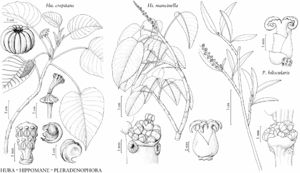Difference between revisions of "Pleradenophora bilocularis"
Phytotaxa 81: 34. 2013.
FNA>Volume Importer |
FNA>Volume Importer |
Revision as of 18:21, 24 September 2019
Shrubs or small trees, 1–8 m. Leaves distichous, clustered at branch tips; stipules triangular, 0.8–1 × 1.5–2.5 mm, erose, hyaline; petiole 1.2–4 mm, glands 0–2, orbicular, axil with tuft of coarse glandular hairs; blade lanceolate, 2–7 × 0.5–1.8[–3] cm, base acute, margins with fine teeth bearing setae, teeth sometimes replaced by orbicular glands, apex acute. Inflorescences: peduncle 0.2–0.6 cm; fertile portion 3–6 cm; staminate cymules numerous, condensed, each with 3–10 flowers per bract; pistillate flowers 0–4 per inflorescence, 1 flower per bract; bracts ovate, 1.5–2 mm, subtended on each side by row or cluster of 5–7 elliptic glands, 0.1–0.3 mm diam. Pedicels 0–2 mm. Staminate flowers yellowish green; sepals 0.5 mm; filaments 0.3–0.8 mm, anthers 0.2–0.3 mm. Pistillate flowers yellowish green; sepals ovate, 1–2 mm; styles 2.5–3.5 mm, connate 1/3 length, free portion coiled. Capsules subglobose, 0.5–-1 cm diam. Seeds 4–5 mm, wider than long; seed coat silver and brown mottled, smooth with verrucose patches. 2n = 22.
Phenology: Flowering and fruiting year-round.
Habitat: Sonoran desert scrub, thorn scrub.
Elevation: 0–1000 m.
Distribution
Ariz., Mexico (Baja California Sur, Sonora).
Discussion
Pleradenophora bilocularis reaches its northern limit of distribution in southwestern Arizona and is widespread in adjacent Sonora, Mexico. Across its range, there is a six-fold variation in leaf width with collections from Baja California being much wider (to 3 cm) and formerly recognized as a distinct variety (V. W. Steinmann and R. S. Felger 1997). The species is a minor source for “Mexican jumping beans” from seeds parasitized by moth larvae. Indigenous populations used the latex as arrow and fish poison (C. E. Bradley 1956).
Selected References
None.
